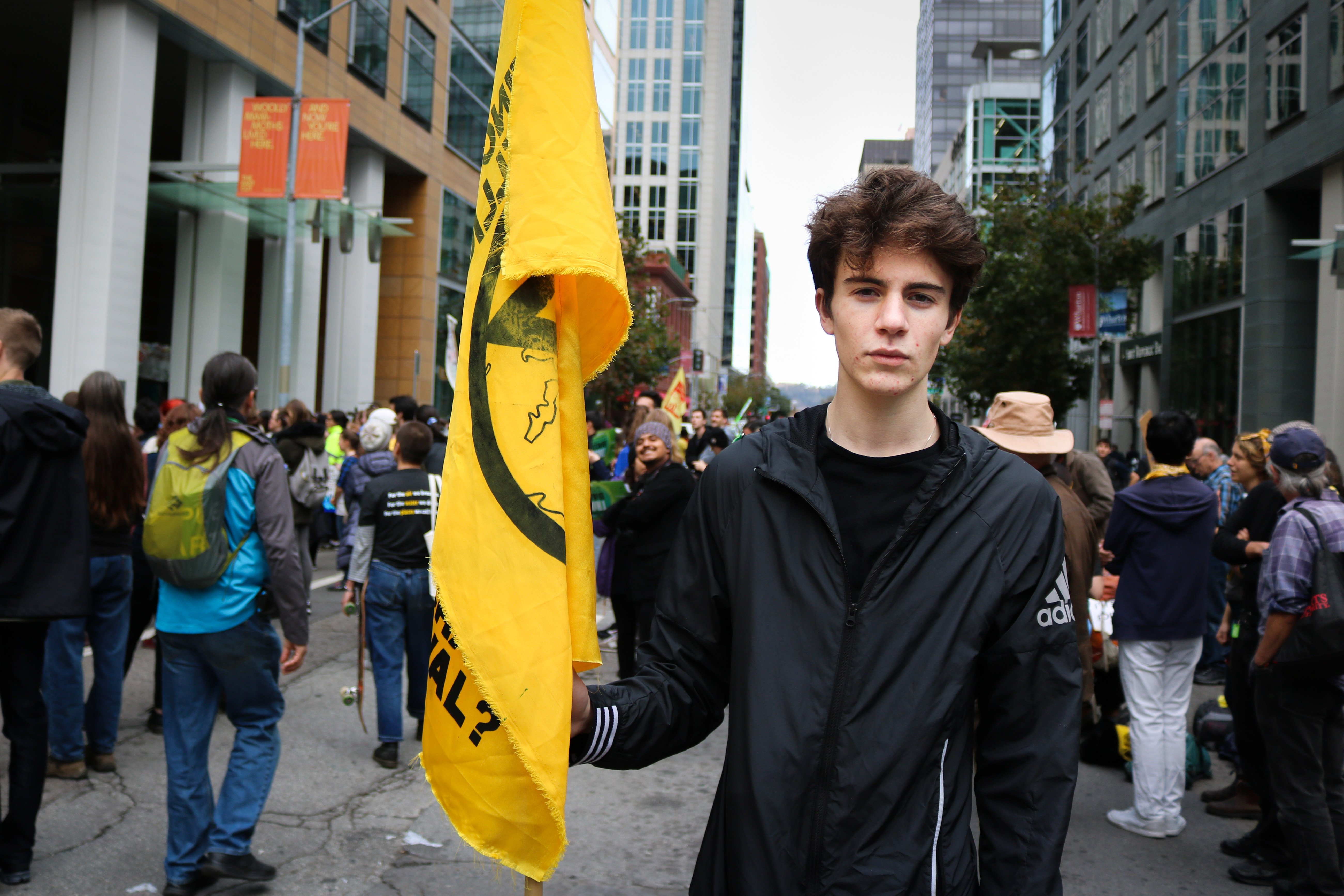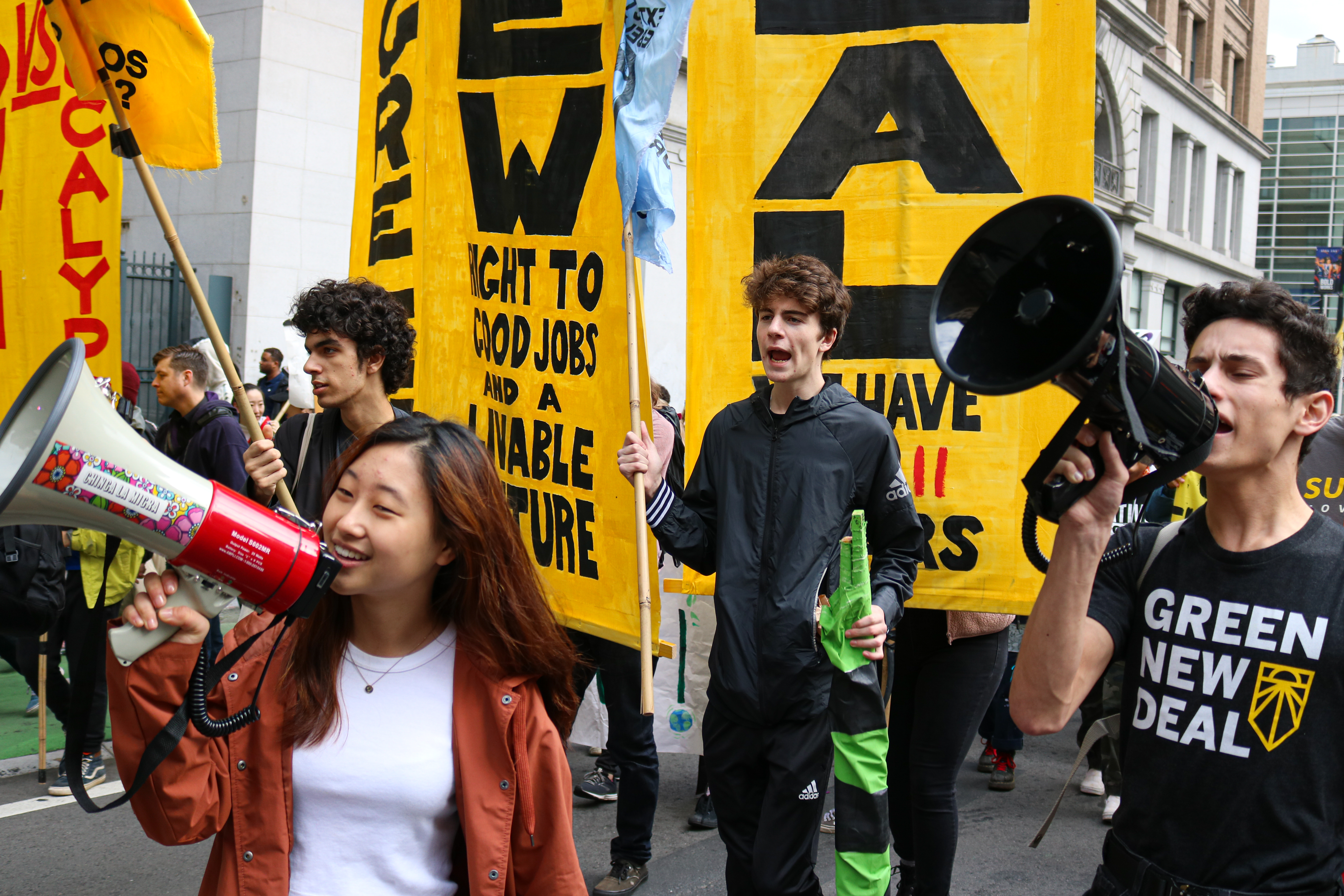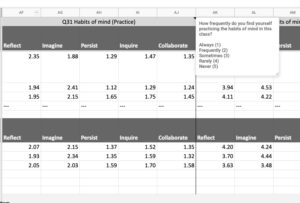
Photo by Gabe Castro-Root
Jonathan Palash-Mizner is the co-coordinator of Extinction Rebellion Youth U.S., an environmental activism group that has gained international recognition for its role in organizing young people to protest government and corporate inaction on climate change. Palash-Mizner, a junior at International High School in San Francisco, co-founded the U.S. youth branch with Sophie Anderson, another youth activist who lives in New York.
This interview has been edited for length and clarity.
Castro-Root: What exactly do you do as a co-coordinator for Extinction Rebellion?
Palash-Mizer: Extinction Rebellion, or XR, is a national organization, but they have different branches in different countries. Every country has a youth subsection of that branch which largely works independently, but we all try to coordinate our actions. So, in the U.S. I am the national co-coordinator of the youth branch. So far, that work has mostly been helping local groups get set up and reaching out through social media and finding people in other locations who are really passionate about climate change and want to start something of their own.
We find them and we give them a lot of the XR resources that are modified to fit youth specifically, and we help them create interest group meetings to bring people together. We’ll usually give it a shoutout on our Instagram so people will know to come. We use the communication system Slack to keep track of what all of our groups are doing.
But there’s also a national organizing component that I think has been a lot bigger than we expected. We represent XR on the Future Coalition¹, a group of organizations that have been the driving force behind organizing this last set of school strikes. That involves managing the Climate Action Fund², agreeing on a list of demands, talking about messaging and media and creating various toolkits for local groups to use.
C-R: Was there ever an agreed upon list of demands for the Youth Climate Strike?
P-M: What we agreed on was that each local strike could have its own set of demands. We did agree on some specific national demands for Future Coalition, but that took a long time to reach consensus on. Some organizations had additional demands that only applied to their organization. But yes, there were five that were agreed on:
First, implementation of sustainable agriculture and transforming our economy to 100% renewable energy by 2030, which means an immediate halt to all leasing and permitting for fossil fuel extraction.
Second, respect for indigenous land and sovereignty, which means stopping all leasing and permitting for resource extraction on indigenous land.
Third, Environmental Justice, which means a transition to renewable energy that invests economically in communities on the front lines of poverty and pollution.
Fourth, protection and restoration of biodiversity, including a halt to all deforestation. Deforestation is a huge problem, and Brazil is, in a word, bad. Oceans are also a massive carbon sink, so protecting them is incredibly important.
Finally, the Green New Deal, which I think is a great piece of legislation. It would definitely help, but it’s also very broad, and specific proposals will be needed as well. It’s also really disappointing that typically pro-environment politicians like Nancy Pelosi have called the Green New Deal the “green dream,” because I don’t know what they’re going to fight for if not that.
C-R: What did organizing for the school strike look like for you?
P-M: I worked a little bit with the local San Francisco strike, but not as much as I would have liked to because national organizing kept me very busy. Youth vs. Apocalypse did the brunt of the organizing work here in San Francisco. They’re a great organization that we’ve worked with before. Nationally, we had weekly calls where we made decisions about media, messaging and demands. We also had the Climate Action Fund, to which organizations could apply for grants. We would usually approve them, but sometimes we would tell them that we didn’t think funds were being allocated properly, so we made adjustments and talked to those organizers about it.
One of the things that I was working on specifically was how the movement would continue after the school strike. I’ve also been facilitating coordination between local groups. For example, if we have a group in Houston and there’s another organization that has a group in Houston and they both want to plan a strike, our job is to connect those two groups and make sure that they work together so that we don’t have repetitive strikes or cross paths, because then the strikes are not as effective.
I also want the climate movement to pick up more in China, but China’s government is kind of scary, so that makes it hard. I would love to help with that more but we’re busy here (and the second biggest polluter) so I don’t know that I’ll personally be able to work much on China. I’m sure, though, that China will become a key point of attention, and I think what will create change there is international pressure.
C-R: What was your experience like at the New York strike?
P-M: It was overwhelming, but it was great. It felt a little bit weird because it didn’t feel like it was my strike since I hadn’t been central to organizing it, but it was still an amazing experience. I was pretty busy, but it was nice when I had moments to just be there and feel the power of the movement. I’m honestly kind of a pessimist, so before I got involved in climate activism it hadn’t even occurred to me that we were going to pull through and solve climate change. I was like “Okay, we’re pretty much goners.” These mass mobilizations give me some semblance of hope, which is a lot better than having none at all. This movement has given me so much more hope and pride in humanity. I didn’t believe that this movement could happen, and now it’s happening and I believe it’s going to keep getting bigger.

Photo by Gabe Castro-Root
C-R: Do you think the school strikes have the potential to make real change?
P-M: Yes. A lot of people are very skeptical about striking as being an effective method of change. And a lot of people focus too much on individual change, like being a vegan. But the fact is that when we have a hundred companies responsible for 70% of carbon dioxide emissions, nothing is going to stop climate change but making those companies stop. And the only way we can make those companies stop is through governmental restrictions. It’s very unlikely that, as long as Trump is in the White House, we’ll be able to get much done politically on a national scale. The day of the strike, President Trump blocked California’s new vehicle emissions regulations³, so he was actually unwriting climate policy as we were striking for climate action and for more climate policy.
But one of the things these strikes do is push for local political change, so we can target city level and state level legislation. We can also shift the conversation. For example, having a climate change town hall for Democratic presidential candidates was huge because climate change has never been that central of an issue before. We’re showing them that climate change is now central to electability, and if candidates don’t come up with a good plan, they won’t be able to stay in power. That’s how we leverage our power as the people, how we leverage our democracy in order to make the people who are supposed to be representing us make the changes we want.
On September 20th, four million people went on strike. When that many people are screaming and yelling about this issue and nothing is happening, it’s hard to have faith in our democracy. But this isn’t the end, luckily, and this is going to keep getting bigger and bigger and eventually people will start to change. At the New York strike, organizers applied for a permit for a hundred thousand people, and the police were like, “No. You’re only going to have five to ten thousand people,” and only gave them a permit for that. And they blew that permit away! So I don’t think that they’re taking us seriously right now. I don’t think they believe that we’re here to stay and we’re serious that we have the support that we do. But the more we force them to believe that, the harder it will be for them to sit there and do nothing. So yes, I do think it can make real change.
C-R: With March for Our Lives, a lot of people were really into the gun control movement for a month, and then they moved on with their lives. How do you plan to keep the momentum of the climate strike going in a way that other movements haven’t been able to do?
P-M: The reason I think the climate movement will move forward in a way March for Our Lives isn’t is because there’s so much gravity to this issue. That’s not to say climate change is more important than other social issues, and one of the things we talk about a lot is intersectionality and how we won’t be able to do this unless we deal with systemic oppression and the root causes of oppression. So climate change to me is the amalgamation of all these forms of oppression. If we don’t deal with it, everyone is going to die much sooner than they otherwise would. And that’s hard to ignore. Like, “Oh, okay, I’m tired so I’m just going to let everyone die.” No, that’s not how that works. To me climate change has the most gravity to it of any social issue I know in terms of living consequences. So we have to keep the pressure on so that these companies can never get this big exhale of fossil fuels into the air.
C-R: Why is it important for young people to be involved in environmental activism?
P-M: We’re going to be the ones impacted the most by the climate crisis, so I believe we have the moral authority to decide what happens to our earth. It’s messed up that many of the people in power right now will not live to see the consequences of their actions. We are going to be the ones to live to see the consequences, so we should have a say in their actions. It’s about self-determination, really, being able to determine our own future and defend our own future. When we as young people can’t vote or run for public office, this is the most important thing we can do. If we don’t do it, who else is going to stand up for us? Obviously, so far no one else has. By and large, our world leaders have neglected us and sacrificed our futures for profit, and that’s disgusting. It’s also very impactful to see waves of children in the streets, and I can’t imagine being in power and seeing this and doing nothing.
C-R: Realistically, do you think that the entire energy industry can be completely transformed in the next ten years⁴ to achieve carbon neutrality?
P-M: One of the things about being a youth in this movement is that I’m not an expert on the science, so I can’t make a definitive statement that scientifically this will or won’t work. But, my short answer is yes. I think it can, because it has to. The fossil fuel industry is a human industry, so what it will take to change this industry is human change, and I think that any type of human change is possible. I think we can reach even the oiliest of CEO’s out there because it’s their future too. Frankly, they don’t deserve the future that we’re fighting for, but their future is also at stake and I don’t see any logical reason to keep drilling for profits if you’re not going to be able to enjoy them later in life.

Photo by Gabe Castro-Root
C-R: One of the criticisms people made about the strike was that all the focus was on climate change being bad, and that there were not many proposed solutions. What kinds of solutions do you hope to see going forward, and why wasn’t that as much of a focus of the strike?
P-M: We do focus a lot on what is bad, and that is a weak point in the movement. But as youth, it shouldn’t even be our job to strike. Even more so, it shouldn’t be our job to come up with solutions because the majority of us aren’t qualified to do that. At some point it may have to come to that, because things really aren’t going well right now in terms of adult support. But to a certain extent we do depend on adults to create the solutions for us at this point in time. I do think there’s a reason that we have focused mostly on what is bad, and that’s because we are youth. I don’t think any of us are kidding ourselves by claiming that we’re environmental scientists. We’re kids—we’re not going to tell you that we know how to save the world, because, frankly, we don’t. But we know that the world needs saving, and we know who does know how to save it, and those people are climate scientists.
One important solution is renewing biodiversity and restoring forests. Those are very important because they’re massive carbon sinks. If we keep letting the Amazon burn, for example, we’re going to lose one of the largest carbon sinks in the world. Another important solution is respecting indigenous sovereignty and prioritizing marginalized communities because the climate crisis has been affecting them disproportionately.
C-R: Can you explain the term Climate Justice?
P-M: Climate Justice encompasses solving climate change, but in a way that prioritizes marginalized communities and protects indigenous sovereignty. It also recognizes how unjust the climate movement has been. The climate movement has historically been incredibly whitewashed and privileged, and it hasn’t stuck up for communities of color. The fact is that there have been indigenous people and people of color fighting for our earth for decades and being completely shut down. That’s something that we as a movement have been trying to change. It’s incredibly important that they have a seat at the table and have control of the table because they’re the ones most affected by climate change.
C-R: What are some of your goals going forward?
P-M: Something that people don’t think about with the 2030 deadline is that we don’t have ten years to choose a plan to solve the climate crisis. We have ten years to choose and completely implement a plan and reach carbon neutrality. The amount of time we have to agree on a plan and actually start rolling it out is so much smaller than that. That’s something we’re working on. We also want to work on welcoming more climate refugees. The climate catastrophe hasn’t been recognized as a valid reason to seek asylum, and that’s a huge problem because especially in the global south, but in the US, too, so many people are needing to seek asylum because of flooding and fires. Climate change is a massive problem, and for too long there hasn’t been any real action to solve it. But the way to fix that is to exercise our rights as people. The government only has the power that we give it, and right now it may not feel like we have much power to leverage, but that’s wrong. We have all the power. If we can unite as people, as a species, this is doable. That seems very overwhelming, and it is. But it’s doable, and it’s what we’re going to have to do.
¹Future Coalition is a network of youth-led organizations that provides “tools, resources, and support” to help youth activists grow their impact across the U.S.
²The Climate Action Fund is a “pool of donations” distributed by Future Coalition to their member organizations. The allocation of funds is decided on by a committee of youth activists.
³Under the 1970 Clean Air Act, California was granted a waiver that allowed it to set tighter vehicle tailpipe emissions standards than those set by the federal government. After the EPA moved to revoke this waiver in September, California, along with 22 other states and the District of Columbia, sued the Trump Administration, arguing that the Clean Air Act gives them the authority to set their own standards. The case is ongoing.
⁴Multiple reports by the U.N. Intergovernmental Panel on Climate Change have found that if global greenhouse gas emissions are not cut by a minimum of 55% by the year 2030, the planet may reach a “tipping point” of irreversible damage to ecosystems around the world.






